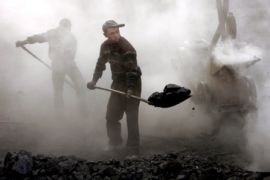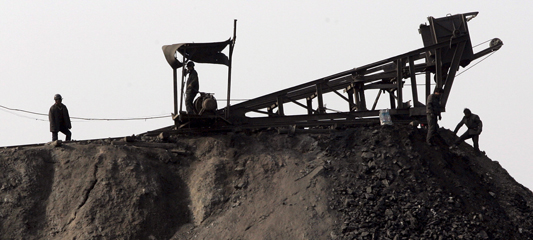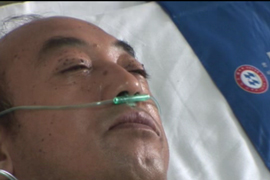
China’s miners toil in misery
People & Power visits the heartland of the country’s dangerous coal industry.
 |
| Coal is driving China’s extraordinary economic growth (EPA) |
As part of a special People & Power series, Chinese film maker Yang Shaobin visited a mine in the heart of the country’s coal-mining district.
The Kailuan mine near the town of Tangshan, in the northwest province of Hubei, is the heart of Chinese coal country. It was here, in 1878, that the national coal-mining industry was born.
Keep reading
list of 4 items‘Mama we’re dying’: Only able to hear her kids in Gaza in their final days
Europe pledges to boost aid to Sudan on unwelcome war anniversary
Birth, death, escape: Three women’s struggle through Sudan’s war
Today there are more than five million miners in China, 100,000 of them working in Kailuan alone.
Production is incessant, with three shifts operating each day, 365 days a year.
Growing reliance on coal and growing unease of its use has been the impact of China’s mammoth coal industry.
Coal is the country’s main source of energy and its emissions are a huge source of concern to other countries in the region and environmentalists who argue it is a major contributor to global warming.
But China’s extraordinary economic growth is built on coal and there are plans for more than 500 coal-fired power stations to be built.
It is a booming and a deadly industry with more than 6,000 miners killed last year alone.
The Kailuan mine is a microcosm of China’s recent history and the life of the mine has mirrored the country’s trials and tribulations.
Originally controlled by the British in 1901, it was taken over by a workers rebellion in 1922, claimed by the Japanese in the second world war, before finally becoming an industry showpiece for China’s leaders.
“Sometimes ten hours, sometimes more, depends how much we need to get done in the day,” one miner says when asked how long he spends at the coalface.
“Sometimes it takes a minimum of seven hours, sometimes its even twelve hours under there.”
Another miner says “it depends on the amount of the work we have to get done in a day, usually eight hours, sometimes we’re not allowed to come up until it’s finished”.
The miners are part of a single 300-strong team who go underground together, work together and, hopefully, all leave together.
Supply and demand
During the shift that People & Power joined them, the men are going down 850 metres. A single lift shaft takes them down the first 600 metres into the bowels of the earth.
“Watch out for the cable,” a miner warns. “It’s got 550 volts running through it. Don’t touch it.”
Six hundred metres down and the temperature is already 30 degrees and rising – the final 250 metre descent is a gradual decline which takes 45 minutes on a rickety old cart.
| People & Power |
This is the frontline of China’s economic bubble and supply is barely meeting local demand.
China has not exported any coal for the past three months and, with a further 500 coal-fired power plants due to be built in the next decade, the country’s insatiable appetite will grow.
Currently, nearly 80 per cent of the nation’s power needs are met by coal from the power stations to the proletariat, from industry to the individual.
It is the black gold that has propelled the rise of the developing nation.
Working in the conditions at Kailuan, it is no wonder that industrial accidents are commonplace.
Tens of thousands of miners are critically injured each year, with many unable to ever return to work.
If they are lucky enough to work for a prestigious mine such as Kailuan, they will receive compensation payments and, in some cases, even a pension.
But in many of the mines, men desperate for work often sign away all their rights. If they are injured, they receive no compensation payments.
The rest of some injured miners’ lives are spent hand to mouth, begging on the streets.
Lower expectancy
One of the miners uses a water cannon but the air is still thick with coal dust that inevitably will coat the lungs of every miner.
The coal dust can cause emphysema, silicosis, anthracosis or black-lung disease, to name but a few ailments.
On average, a miner is expected to live 15 years less than other workers. Many are even less fortunate as accidents such as flooding and collapsing mine shafts are a frequent reality.
State media reported in 2007 that mining fatalities in China officially dropped by one-fifth to 3,786 deaths – still the highest in the world. But some people estimate the real figure to be four or five times that.
 |
| The thick coal dust inevitably coats the lungs of every miner |
Many miners’ wives and family wait on the surface, hoping that the men will be home for dinner. But one woman says she only cooks potatoes because they cannot afford meat.
Being paid between $200 and $300 a month, a miner’s family lives barely above the poverty line.
Kailuan is unusual in that it does provides basic housing for their miners, a hangover from the days when the state provided and everyone was working towards the common good.
While the industry may still be state controlled, mining companies are now governed by the business bottom line. The workers are now expendable and housing, health and education no longer have to be provided.
When the men descend the shafts to work, some of their wives may be lucky enough to find work on the surface, such as a job in the mine’s control room.
Many of the miners are migrant workers from provinces such as Sichuan. While some bring their families with them, most will leave them at home, sending some of their wage home and only returning once a year.
But after spending years working in mines, their chances of returning home to a healthy life are very limited.
At a nearby hospital in the town of Beidaihe, Shao Lun is being treated for acute emphysema, a lung disorder caused by years of inhaling coal dust.
Lung cleaning
“The mine I work in is an open mine,” Shao Lun says. “I was doing the drilling to find the other location of the coal.”
He has checked into the Coal Miner’s Sanatorium to have his lungs cleaned out for the second time.
“He went back to work after his first treatment,” a nurse says. “He should have changed to a new position.”
 |
| Shao Lun has had his lungs cleaned of coal dust on two occassions |
Shao Lun agrees. “I should have changed to a different post,” he says.
“The operation cleans out the dust from the lung cells – the lung function will be improved after the cleaning,” the nurse says.
“The pressure of the heart will be improved, and should slow down the spread of the disease.”
The operation is so invasive that Shao Lun now has to spend at least a month in the hospital before being safely discharged.
However, very few miners are as lucky as Shao Lun.
As a manager in one of the leading state-run companies, he qualified – one of only 900 miners a year – to receive this life-saving operation paid for by the state.
“We have helped about 4,000 patients since April of 1991,” the nurse says. “Every year we treated about 500 patients.”
In recent years, the Chinese government have begun a push towards mine safety. State-run mines like Kailuan are at least supposed to meet certain health and safety standards.
But the majority of accidents and deaths occur in small, illegal coal mines. There are thousands of these privately run mines in the coal belt.
In these mines, there is no regard for the worker’s right to life. Migrant workers are considered expendable and a huge number of workers die in these mines.
China’s industrial heartland feels more like a cemetery by the day, each mine shaft standing over the blackened soil like an unmarked gravestone.
Beneath the surface, men toil in tunnels, hundreds of miles of dark and damp, where their deaths go unnoticed.
People & Power’s special series on China will continue until June 11 2008. Click here for more details.